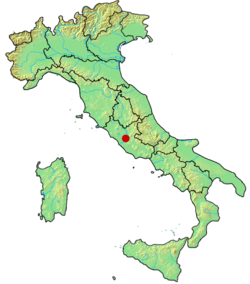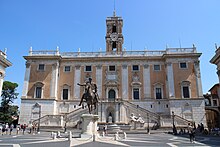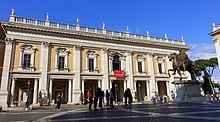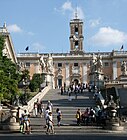Piazza del Campidoglio
Piazza del Campidoglio | |
|---|---|
| Public square | |
 Piazza del Campidoglio, on the top of Capitoline Hill, with the façade of Palazzo Senatorio | |
| Features | |
| Design | Michelangelo |
| Completion | 16th century |
| Architectural style | Ancient Roman architecture |
| Owner | Metropolitan City of Rome |
| Location | Rome, Italy |
 Map of Italy | |
| Coordinates: 41°53′36″N 12°28′58″W / 41.89333°N 12.48278°W | |
Piazza del Campidoglio ("Capitoline Square") is a public
History
Piazza del Campidoglio on the top of Capitoline Hill, took on its current layout in the 16th-century, when
Since the Middle Ages, the Piazza del Campidoglio has been the seat of the civil administration of the city. On the remains of the Tabularium stood a fortress of the Corsini family, which the Roman people took possession of in 1114. It was destined as the seat of the city senate and was enlarged in the 14th century. The dirt clearing in front, which accommodated the gatherings of the people, was flanked by buildings intended as the headquarters of the Banderesi (the captains of the city militia).[2][3]
Michelangelo


Michelangelo di Lodovico Buonarroti (1475–1564), known as Michelangelo, was a
The existing design of the Piazza del Campidoglio and the surrounding palaces was created by Michelangelo. At the height of his fame, Michelangelo was offered the opportunity to build a monumental civic plaza for a major city as well as to reestablish the grandeur of Rome.[4]
Michelangelo's first designs for remodeling the square date to 1534. From 1534 to 1538 Michelangelo completely redesigned the square, drawing every detail and making the Capitoline no longer turn towards the Roman Forum but towards the St. Peter's Basilica, which represented the new political center of the city. In 1546, Michelangelo produced the oval design for the piazza that included complex spiraling pavement with a twelve-pointed star at its centre.[5]
Michelangelo provided fronts to the official buildings of Rome's civic government, the Palazzo dei Conservatori, Palazzo Senatorio, and Palazzo Nuovo. Michelangelo designed a new façade for the dilapidated Palazzo dei Conservatori and he designed the Palazzo Nuovo to be a mirror complement, thereby providing balance and coherence to the ensemble of existing structures.[1] The construction of two of these buildings was carried out after his death under the supervision of Tommaso dei Cavalieri.[5]
The work went so slowly that Michelangelo could only see the completion of the double staircase which served as the new access to the Palazzo Senatorio, with the positioning of the two statues depicting the two river gods of the “Tiber” and the "Nile.” The façade and the top of the tower was still incomplete, while the Palazzo Nuovo had not started.
Equestrian statue of Marcus Aurelius


The Equestrian statue of emperor Marcus Aurelius in a gilded bronze statue, previously located in Piazza San Giovanni (where the Lateran Obelisk is now). Michelangelo positioned the statue to stand in the center of the square set in a paved oval field. The original statue, after restoration, is now kept in the Capitoline Museums, while a copy of it has been placed in the square.[6]
Pope Paul III commissioned Michelangelo to provide a setting for the statue and to bring order to an irregular hilltop already encumbered by two crumbling medieval buildings set at an acute angle to one another.[7]
Capitoline Museums

The Capitoline Museums (Italian: Musei Capitolini) are a group of art and archaeological museums in the Piazza del Campidoglio. They include the Palazzo dei Conservatori, Palazzo Senatorio, and Palazzo Nuovo. The three palazzi are now home to the Capitoline Museums.[1]
The Palazzo Senatorio and Palazzo dei Conservatori form an 80° angle, on which he aligned the new façades, to expand the perspective towards the visual focus by the Palazzo Senatorio. For this purpose, Michelangelo had the idea of building a new building, Palazzo Nuovo, to close off the perspective towards the basilica of Santa Maria in Ara Coeli and to pave the square.
Palazzo dei Conservatori

The Palazzo dei Conservatori (English: Palace of the Conservatories) was built in 1453, when Pope Nicholas V, had Italian sculptor and architect Bernardo Rossellino build the palazzo on top of a sixth-century Temple of Jupiter Optimus Maximus, to create the headquarters for the local magistrates, named Conservatore of Rome. Today, portions of the temple podium and foundations can be seen behind the Palazzo dei Conservatori, in an exhibition area built in the Caffarelli Garden, and within the Capitoline Museums.[8] A part of the eastern corner is also visible in the via del Tempio di Giove.[9]
The front porch of the Palazzo dei Conservatori sheltered offices of various guilds. Here disputes arising in the transaction of business were adjudicated, unless they were of sufficient importance to go before a communal tribunal, such as that of the conservatori. It was a natural place for such activity. Until the 1470s the main market of the city was held on and around the Campidoglio, while cattle continued to be taxed and sold in the ancient forum located just to the south.[10]
Rossellino built a building with a round arched portico on the ground floor and a façade with cross windows and paired loggias. The orientation of the pre-existing structures was preserved according to a design principle identical to the one that Rossellino implemented subsequently in the town of Pienza, creating a trapezoidal square. The renovation also involved the Palazzo Senatorio, but were interrupted by the death of the pope.[2]
The Capitoline Wolf sculpture was housed in 1471 in the Palazzo dei Conservatori.[11]
The 15th-century Palazzo dei Conservatori, at the Capitoline Museums, was almost demolished in 1540 by Michelangelo, but the fifteenth-century design was documented in the drawings by the Dutch painter Maarten van Heemskerck made between 1536 and 1538. He redesigned the Palazzo dei Conservatori, removing all the previous structures and matching it with the Palazzo Senatorio. He added a double stairway which was used to access the new entrance, no longer facing the forums but towards the square. He also modified the façade, in order to bring it into line with that of the Palazzo dei Conservatori and that of the Palazzo Nuovo facing the church of Santa Maria in Ara Coeli inserting pilasters of giant order, which appeared for the first time in the public buildings, a cornice with a baluster (another new element) and a tower. He added a portico façade to the Palazzo dei Conservatori and inserted giant order pilasters and a balustraded cornice with statues. Michelangelo also designed the steep ramp staircase of the Cordonata and the balustrade from which one overlooks the underlying Piazza d'Aracoeli at the base of Capitoline Hill.[6][5]
Palazzo Senatorio



The Palazzo Senatorio (English: Senatorial palace) was built during the 13th and 14th centuries. It stands atop the Tabularium, which had once housed the archives of ancient Rome. Peperino blocks from the Tabularium were re-used in the left side of the palazzo and a corner of the belltower. It now houses the Roman city hall, after having been converted into a residence by Giovanni Battista Piranesi for the Senator Abbondio Rezzonico in the 18th century.[12]
Its double ramp of stairs was designed by Michelangelo. This double stairway to the palazzo replaced the old flight of steps and two-storied loggia, which had stood on the right side of the palazzo. The staircase cannot be seen solely in terms of the building to which it belongs but must be set in the context of the piazza as a whole.
In 1587, when the branch of the new aqueduct of the Acqua Felice reached the Campidoglio, Pope Sixtus V announced a public competition for the construction of a fountain on the square. Matteo Bartolani's project was the winner. Bartolani was the architect who was initially commissioned to build the Acqua Felice aqueduct. It was a big project, which was only partially realized with the construction of two tanks leaning against the center of the façade of the Palazzo Senatorio, between the statues of the two rivers and under the niche containing Athena.
Palazzo Nuovo

The Palazzo Nuovo (English: New Palace) was constructed in 1603 to close off the piazza's symmetry and hide the tower of the Santa Maria in Ara Coeli. It was finished in 1654 and opened to the public in 1734. Its façade is an identical copy of the Palazzo dei Conservatori, made using Michelangelo's blueprint when he redesigned the Palazzo dei Conservatori a century earlier.
Cordonata
The Cordonata (
The two fountains that in 1588,
-
The "Cordonata" access to Piazza del Campidoglio, with the statues of theDioscuri
-
The Castor and Pollux Roman 3C AD
-
Monument of the politician Cola di Rienzo
-
The Capitoline Hill cordonata leading from Via del Teatro di Marcello to Piazza del Campidoglio
Final interventions
The Campidoglio square was finished in the 17th century. Benito Mussolini ordered that the paving for the square be completed to Michelangelo's design, done by it:Antonio Muñoz (1884-1960) in 1940, based from a print by Étienne Dupérac.[16]
The geometric paving of the square and the equestrian statue of Marcus Aureliu appear on the
-
Engraving by Étienne Dupérac, which was used to reproduce Michelangelo's design of the pavement that it:Antonio Muñoz used to create the current pavement in 1940
-
The Italian 50 euro cent coin depicting the Equestrian Statue of Emperor Marcus Aurelius
-
Ten thousand lire banknote
-
The Capitoline Wolf, bronze sculpture
See also
References
- ^ a b c Wallace, William (2010). Michelangelo: The Artist, the Man, and His Times. Cambridge: Cambridge University Press. pp. 229–231.
- ^ )
- ^ Gregorovius, Ferdinand (1894). History of the City of Rome in the Middle Ages. p. 403. Retrieved 17 February 2023.
{{cite book}}:|work=ignored (help) - ISBN 9780500231074.
- ^ a b c d Morgan, Charles H. (1966). The Life of Michelangelo. New York: Reynal and Company. pp. 209–211.
- ^ a b c Von Einem, Herbert (1973). Michelangelo. London: Methuen and Co. Ltd. pp. 197–206.
- ^ Fazio, Michael (2008). Buildings across Time: Third Edition. Boston: McGraw-Hill. pp. 310–311.
- ^ Claridge 1998, pp. 237–238; Albertoni & Damiani 2008
- ^ Coarelli, 2014; p. 32
- ^ Charles Burroughs, Michelangelo at the Campidoglio: Artistic Identity, Patronage, and Manufacture (IRSA s.c., 1993) pp. 91 "Palazzo dei Conservatori, Campidoglio (The Capitoline Hill)" Accessed March 21, 2012 [1] Archived 2012-02-04 at the Wayback Machine
- ^ Adriano La Regina, "Roma, l'inganno della Lupa è "nata" nel Medioevo. La Repubblica. 17 November 2006
- ^ Lowe, Adam. "Messing About With Masterpieces: New Work by Giambattista Piranesi (1720-1778),"Archived 2019-01-30 at the Wayback Machine Art in Print, Vol. 1 No. 1 (May-June 2011), p. 23 fn. 3.
- )
- ^ Fazio, Michael (2008). Buildings across Time. Boston: McGraw-Hill. pp. 310–311.
- ^ ""Campidoglio" accessed march 23, 2012". Archived from the original on 29 December 2019. Retrieved 30 March 2012.
- )








